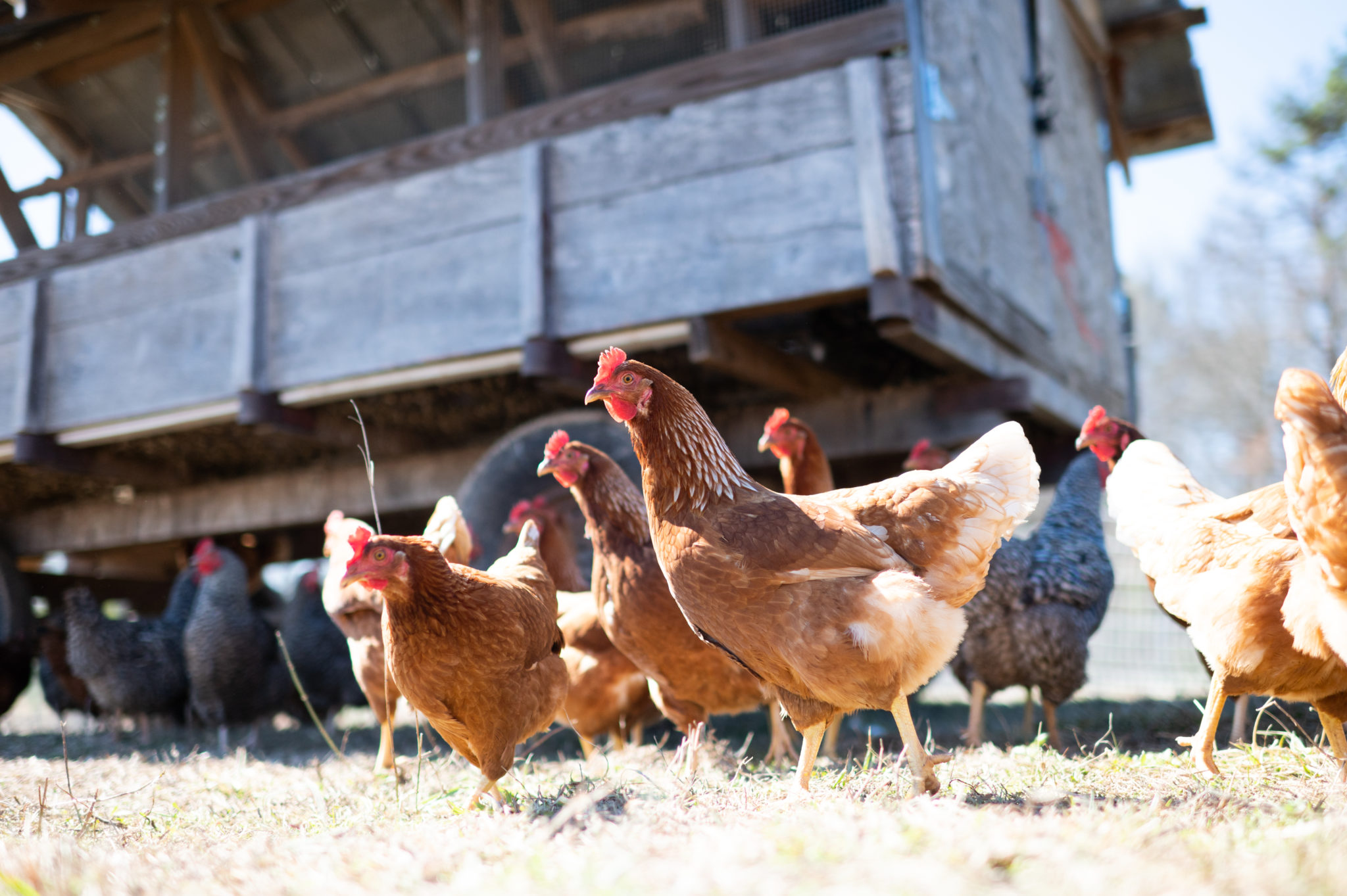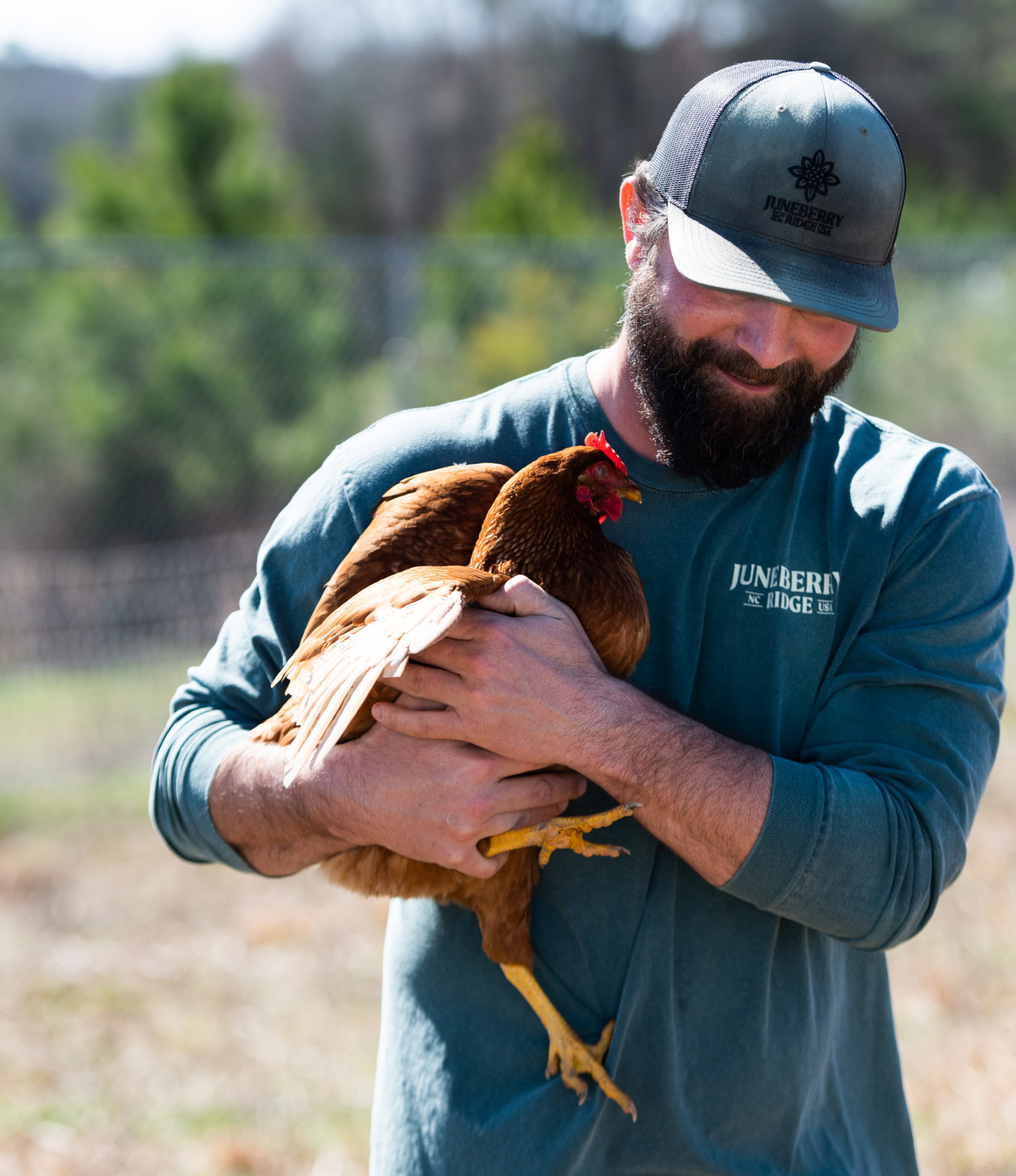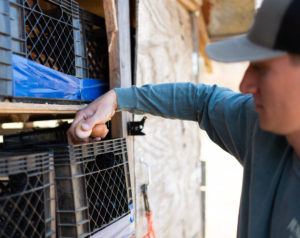Our most effective soil engineers work for kitchen scraps, wood chips, cow manure, clean water, and joy.
They’re chickens, and nothing makes them happier than scratching through a pile of compost and turning compacted, exhausted dirt into rich, garden-ready soil. They are a key component of our long-term plans for Juneberry Ridge. Driven by our aspiration to change the way the world grows, we are on a path to make this land a better place for future generations.
Chickens changed how I see food and agriculture.
My experience with chickens on my own family farm began about 12 years ago, when my wife and I were facing health issues related to the foods we were eating. In our research into food and how it could be better for us, we started reading and listening to experts such as Joel Salatin of Polyface Farms, Justin Rhodes (the chicken ninja master) of Abundant Permaculture, Karl Hammer of Vermont Compost, and many others. Our first 25 hens were the start of a long learning process that opened our eyes to the world of regenerative agriculture – and eventually led me to Juneberry Ridge.
Our chickens are co-workers, they’re farmers too.
They keep our pastures healthy by scratching and aerating. They reshape and revitalize soil for future gardens by working carbon and nitrogen into the earth. They help dispose of kitchen waste. And they produce healthy, delicious ingredients that shine in the food that comes out of our kitchen.

A force for good all over Juneberry Ridge.
We have 2 different groups hard at work.
- The “broilers” are larger meat birds that we acquire as chicks; once they have grown up a bit, we move groups of them around the property, regenerating the soil in areas like our West Hinson Pasture. In 2022, a rotation of about 150 broilers have been grazing a half acre of land in front of our greenhouse, revitalizing the soil there in preparation for a pollinator garden of wildflowers.
- Behind the greenhouse, we have another group of “layers” – about 100 hens working a quarter-acre patch that needs a lot of attention. It started as bare clay. We add wood chips, compost, and the layers work intensively to create the topsoil that will become a kitchen garden to expand our seasonal vegetable offering for hospitality guests.
It is important to keep these flocks rotating – they benefit from variety. Keeping them in one place for too long can be unhealthy for both the soil and the birds.
Happy chickens work hard.
They get up early in the morning and get right to business. They spend their day in cheerful toil, enjoying the company of their peers and competing for the tasty treats they find in the dirt. When one of them discovers a rich deposit, others gather around to get in on the goodness. By the time the sun goes down, they are all snuggled into the coop, tired and resting, getting ready to do it all again the next day.

With the mix of hard work and joy they bring to life, I see chickens as a great role model for teenagers.
So you can imagine how gratifying it is that my preteen daughter Stella has grown to share my appreciation for the chickens on our own small farm. She has taken over management of our flock, collecting the eggs, monitoring their work, and deciding when they need to be moved.

Pastured eggs: Happy cChickens make them tastier and healthier.
Once my family grew accustomed to the eggs that our own pastured chickens give us, conventional store-bought alternatives seemed like trash. I mean that literally. After four years of enjoying eggs we raised ourselves, I picked up regular eggs at the store for an occasion when I thought we’d need more. The next morning, my daughter was cooking breakfast, and the store-bought eggs didn’t even make it onto the stove. She threw them away. They just didn’t smell right. They didn’t look right. She knew she did not want us eating them. Her nose and eyes were not lying to her – a study at Penn State University showed that eggs from pastured chickens contain twice as much vitamin E and long-chain omega-3 fats, and more than double the total omega-3 fatty acids. The nutrition content can be analyzed, but the difference in taste and texture – you just have to experience that for yourself.
During their most productive ages, each “layer” will produce about 300 eggs per year.
That healthy, delicious bounty goes to our kitchen and becomes the basis for many of the signature dishes that our guests enjoy most. They can taste the difference. In commercial chicken farms, hundreds or even thousands of birds are kept in small cages. Their beaks are usually cut down to keep them from harming each other. Both our broilers and our layers always have plenty of space, and you can see the joy in their behavior. They squawk and socialize, running with glee to scratch through new piles of dirt, digging for worms and nuts. They roam in groups, digging into piles of dirt for the dust baths that they enjoy. They spend time in pastures, gardens, and forests – which are the terrain where chickens originally evolved to find nuts, insects, and worms in the compacted forest floor.
Pastured poultry can change the world.
I know so many families whose passion for regenerative agriculture started with keeping a few chickens so they could enjoy better eggs. These hardworking, happy birds are vital to the big plans we have for Juneberry Ridge. Their natural behaviors regenerate our land. The healthy eggs and meat we get from them nourish our bodies. And for me at least, watching them live and work with joy and purpose is inspiring.


